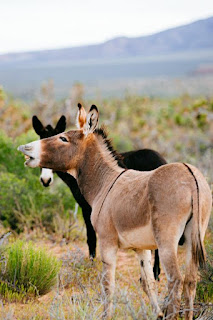Donkey
Introduction
The donkey is a domesticated equine. It derives from the African wild
ass, Equus africanus, and may be classified either as a subspecies
thereof, Equus africanus asinus .It was domestic in Africa some
5000–7000 years ago and has been used mainly
as a working animal since that time.
Uses of donkeys
Donkeys are multipurpose animals and can have many uses including
for children to ride, for driving and showing, light draught work, a friendly
animal or simply as pets. An average donkey of approximately 11 hands high or
160 kg can carry up to 50kg on its back or can pull up to twice its bodyweight
on level ground.
Donkeys are not similar to horses; they differ physically,
mentally and emotionally. Donkeys are more long-suffering in their behavior and
tend to surprise less than horses. Compared to horses, donkeys show limited
fear response to novel situations and this can be mistaken for stubbornness
rather than fear.
Below there are some uses of donkey
1.
For roughly 5000 a long time,
the jackass was being utilized as a benefit creature. Of the world's more than
40 million jackasses, roughly 96 percent are in immature nations, in which they
are fundamentally utilized in travel or farming as pack creatures or for draft
work. The jackass appears to be the poorest source of rural quality, after
human work.
2.
They seem to be introduced or
utilized for water-raising, sifting, processing as well as other work. Those
dwelling at or beneath subsistence levels are regularly related with working
jackasses. A few social orders that preclude ladies from working in
horticulture with bulls don't apply this unthinkable to jackasses, empowering
both genders in utilizing them.
3.
For meat and milk, several
donkeys are bred. Worldwide, roughly 3.5 million donkeys and mules were killed
for meat per year.
4.
Donkey milk fans also consume
it because of its beneficial effects that go far beyond its nutritional value.
5.
Asses' milk has great rates:
the going value in Italy in 2009 was EUR 15 per litre, and Croatia registered a
price of EUR 6 per 100 ml in 2008.
6.
Donkey skin was used during
the manufacture of parchment in history
Donkey’s milk is being given to newborns in certain communities of world. When a baby is born, the grandmother in the family suggests donkey’s milk to the newborn, the fairy tale being is that it enhances growth, promotes brain growth, and improves voice. It is also supposed to be an effective remedy for cough, liver problems, loss of hunger and tiredness. Neonatologists and other healthcare personnel worldwide insist on exclusive breastfeeding for the first six months of life and at the same time warn against harmful and unhygienic feeding practices.donkey milk price
The promotion of breast milk is emphasized worldwide, as it is species
specific, enhances brain development, prevents infection and improves
mother-child bonding. There is no scientific evidence for the use of donkey’s
milk in newborns. Myths and superstitions should not be permissible at the cost
of safe feeding practices. Cognizance of prevailing damaging feeding practices
in various communities and parts of the country should be a first step.
Mothers’ education and community awareness in this direction should be actively
promoted as a deterrent to these practices. Exclusive breast-feeding in the
first six months of life is the dictum. The grandma recipe of giving donkey’s
milk should give way to safe feeding practices. Not only the neonatologists and
health workers, but the community as a whole should play a definitive, positive
role.
Donkeys at risk of becoming extinct due to illegal trade
The skins are used in the manufacture of beauty products, the high
demand for skins and the high price of the skins is leading to the theft and
killing of donkeys. According to a report published by the British news
agency, there is a huge demand for medicine made from donkey skin gelatin in
China. This medicine is known as 'Ejiao' in China. It is claimed to have health
improving, beauty and 'preserving youth' properties. Gelatin' preparation
For this, donkey skin is boiled and made into powder, tablets or
liquid form.Campaigners against the controversial donkey skin trade say people
who rely on donkeys for income are falling victim to the growing popularity of
the drug.
A British charity that has been actively working against the
donkey fur trade since 2017. In a new report, the organization said, 'According
to an estimate, at least 5.9 million donkeys are killed for their fur worldwide
every year. It is estimated that there are 53 million donkeys in the world and
about two-thirds of them are in African countries. Animal welfare laws in
African countries are reportedly lax and vulnerable to exploitation by gangs
involved in the donkey fur trade. The export of donkey skins is legal
in some countries and illegal in others. But high demand for skins and high
prices of skins are leading to theft and killing of donkeys. The Vulture
Sanctuary says it has learned that vultures are being transported across
international borders to places where their trade is legal.
But now the situation may be a little better as the governments of
most African countries and Brazil are considering banning the slaughter and
export of vultures in view of the dwindling population of vultures. According to
a report by the British news agency, the skins of donkeys are used by the
makers of the medicine Ajiu in China. But according to the country's Ministry
of Agriculture and Rural Affairs, the number of donkeys in the country has
declined from 11 million in 1990 to less than 2 million in 2021. After that,
Chinese companies started buying donkey skins from abroad. Regular donkey
slaughterhouses were established in Africa, South America and parts of Asia

